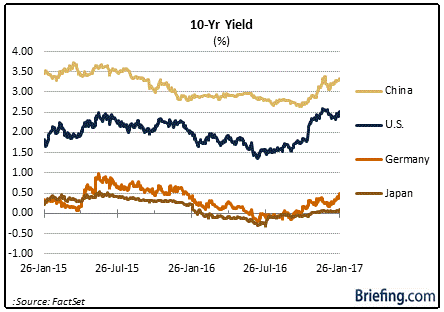Originally posted at Briefing.com
Without looking it up, can you name all five members of the boy band 'N Sync? Don't be disappointed if you didn't get past Justin Timberlake and Lance Bass, but if you got the third, fourth and/or fifth members, give yourself a synchronized high-five. Now, stop to consider that there is another band in sync these days and it includes the U.S., Germany, the eurozone, China, and Japan.
There's little chance anyone will forget the names of those five band members when discussing the global economy, especially when that group is turning out regular hits these days with their manufacturing Purchasing Managers Index (PMI) reports.
That's right. These countries are all in sync with manufacturing PMI readings that are trending higher.
That's an encouraging consideration for a global economy that has been stuck in a low-growth rut and it could hold some important ramifications for monetary policy and global markets.
Eye on PMI
The uptrend began to take root in early 2016, yet it started to ramp up last summer, which means it had its origin before the U.S. election.
Everyone is well acquainted by now with how the U.S. stock market has responded to the election outcome, yet U.S.-centric investors may not be aware of how the markets of other band members have fared. In brief, they have outperformed the S&P 500, with the exception of the Shanghai Composite Index.
That outperformance has been tied in part to the persistence of monetary policy that has remained accommodative at the same time the Federal Reserve has been raising its policy rate and pointing to the likelihood that other rate hikes are bound to follow. China's underperformance, meanwhile, has been tied in part to capital outflows and government efforts to rein in equity speculation.
Weaker currencies, particularly in the case of the euro and the yen, have provided some added ballast as investors in the eurozone and Japan have relished the thought that those weaker currencies should help bolster economic growth through increased export activity and revive some inflation that has been sorely lacking in those respective regions.
Still, there becomes a point where one needs to be careful what they wish for.
Investors in the eurozone and Japan have embraced the reflation trade more wholeheartedly since the U.S.election, mindful that their central banks don't appear to be entertaining thoughts of tightening policy. In other words, they are getting the best of both worlds: improving growth and easy monetary policy.
The U.S. for its part has rallied on the prospect of improving growth, yet it has a festering awareness that stronger growth could invite an accelerating rate of inflation that leads to an accelerated pace of rate hikes.
More Than One Show in Town
The equity markets haven't been the only show in town. Sovereign bond markets have been showing a different form as well. They have been weakening as equity markets have been strengthening.
That weakness has been a byproduct of multiple factors:
- The unwinding of safety trades
- Some rotation out of bonds and into equities
- Currency swings; and/or
- Worries about a pickup in inflation
Where those market rates go — and why — will ultimately dictate how far the equity markets go.
For the time being, the backup in government bond yields is being looked upon by the stock markets as more of a coincident indicator in the sense that it reflects more optimism about a long-awaited pickup in economic growth than it does menacing concerns related to inflation getting out of hand.
What It All Means
Synchronized global growth is perhaps the best thing a central banker could ask for, as it would provide some validation for policies that have long been criticized for lacking effectiveness. The trade-off, though, could eventually be a synchronized tightening effort if manufacturing activity continues to gather strength, economic growth rates increase, and, of course, if inflation rates accelerate.
The latter have shown some vitality of late in the U.S. and the eurozone, but the rubber has really yet to meet the road and so equity and bond markets continue to go about their respective business in a relatively orderly fashion.
Bond markets, however, are likely to sniff out a stark inflation threat earlier than equity markets will and that sniff test could come as a halting surprise to the equity market rally.
Bond king Bill Gross has suggested a break of 2.60% on the upside for the 10-year yield would mark the beginning of a secular bear bond market and would be "...the key to interest rate levels and perhaps stock price levels in 2017." The other bond king, Jeffrey Gundlach, instead thinks a 3.00% yield on the 10-yr note would be the end of the bond bull market and a "really big number" that could pose a problem for the stock market and housing market.
Those men are recognized experts in their field, but clearly, they have creative differences much like Justin Timberlake and Lance Bass might have had back in the day.
Still, the point remains that bond yields are something equity investors need to be keeping a close eye on. If they lurch higher because of a pickup in synchronized growth, or otherwise, the equity market rally, as a boy band once sang, could go "Bye, Bye, Bye."
Photo credit: Shutterstock










